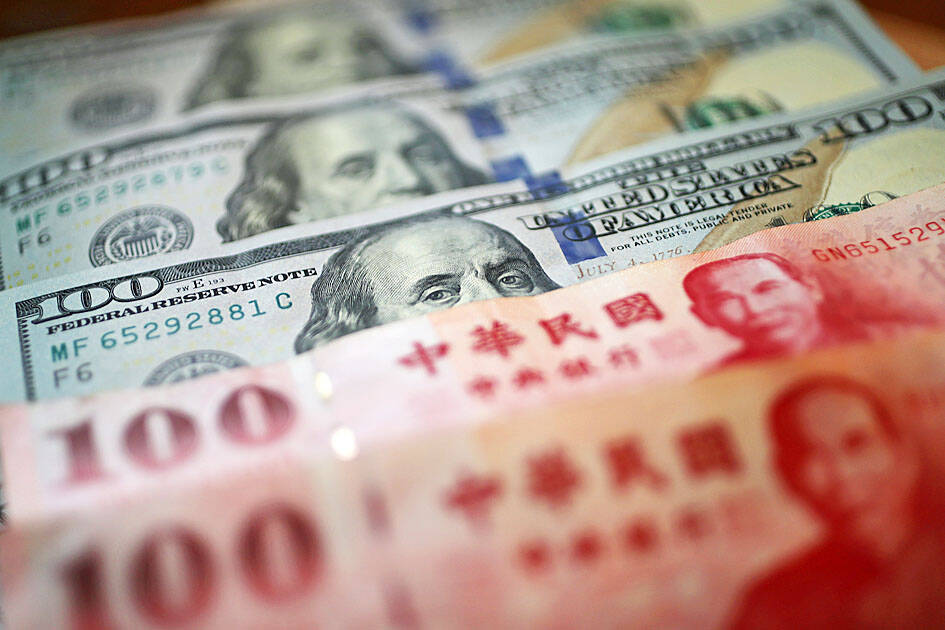Taiwan’s life insurers look set to lift their currency hedging from near record lows in an attempt to shield overseas assets from further swings in the New Taiwan dollar.
Insurers hold more than US$700 billion of foreign currency assets, making them a key source of demand for bonds issued overseas, but they had foreign derivatives equivalent to 47.7 percent of these assets by the end of June, near an all-time low, according to Bloomberg analysis of company presentations.
Taiwanese insurers were hit hard earlier this year, when the NT dollar had its biggest one-day advance since 1988. The relatively low use of derivatives now leaves room for insurers to ramp up their hedging as traders brace themselves for another rally in the NT dollar.

Photo: CNA
“With the expected start of [US] Federal Reserve rate cuts in September, which is likely to lead to a decline in the dollar index, life insurers may further increase their hedges as they bet on a weaker dollar,” BNP Paribas SA rates and markets strategist Chandresh Jain said.
More protection would allow insurers to push ahead with plans to increase exposure to overseas assets. Fubon Life Insurance Co (富邦人壽) aim to add US bonds to back US dollar-denominated policies and adopt a more flexible hedging strategy, while Cathay Life Insurance Co (國泰人壽) is set to increase foreign bond allocations and lengthen currency swaps maturities.
Still, hedging remains expensive. Wagers on NT dollar gains, along with stronger demand for protection, can drive up non-deliverable forward (NDF) premiums. Life insurers faced a near 14 percent cost to hedge via NDFs in May when the NT dollar surged, Bloomberg-compiled data show.
“By the time life insurers considered hedging, the cost had already become prohibitively expensive,” Jain said.
While that cost has now eased to about 3.5 percent last week, it still offsets the bulk of the yield on benchmark Treasury 10-year notes.
Many expect the Fed to resume easing rates this week, pressuring the US dollar, with JPMorgan Chase & Co forecasting an almost 7 percent gain for Taiwan’s currency by year-end. Focus would also be firmly on Taiwan central bank’s policy decision on Thursday, with fresh equity inflows adding to upside risks and fueling demand for hedging.
“Foreign inflows are currently the dominating factor,” Bank of New York Mellon Corp senior Asia-Pacific market strategist Wee Khoon Chong (張偉勤) said.
“The US dollar is weak with prospects for Fed easing. Taiwan dollar valuations are no longer stretched as have been case in the past few months. All of these give clear green light for the Taiwan dollar to strengthen,” he said.

SEMICONDUCTOR SERVICES: A company executive said that Taiwanese firms must think about how to participate in global supply chains and lift their competitiveness Taiwan Semiconductor Manufacturing Co (TSMC, 台積電) yesterday said it expects to launch its first multifunctional service center in Pingtung County in the middle of 2027, in a bid to foster a resilient high-tech facility construction ecosystem. TSMC broached the idea of creating a center two or three years ago when it started building new manufacturing capacity in the US and Japan, the company said. The center, dubbed an “ecosystem park,” would assist local manufacturing facility construction partners to upgrade their capabilities and secure more deals from other global chipmakers such as Intel Corp, Micron Technology Inc and Infineon Technologies AG, TSMC said. It

EXPORT GROWTH: The AI boom has shortened chip cycles to just one year, putting pressure on chipmakers to accelerate development and expand packaging capacity Developing a localized supply chain for advanced packaging equipment is critical for keeping pace with customers’ increasingly shrinking time-to-market cycles for new artificial intelligence (AI) chips, Taiwan Semiconductor Manufacturing Co (TSMC, 台積電) said yesterday. Spurred on by the AI revolution, customers are accelerating product upgrades to nearly every year, compared with the two to three-year development cadence in the past, TSMC vice president of advanced packaging technology and service Jun He (何軍) said at a 3D IC Global Summit organized by SEMI in Taipei. These shortened cycles put heavy pressure on chipmakers, as the entire process — from chip design to mass

People walk past advertising for a Syensqo chip at the Semicon Taiwan exhibition in Taipei yesterday.

NO BREAKTHROUGH? More substantial ‘deliverables,’ such as tariff reductions, would likely be saved for a meeting between Trump and Xi later this year, a trade expert said China launched two probes targeting the US semiconductor sector on Saturday ahead of talks between the two nations in Spain this week on trade, national security and the ownership of social media platform TikTok. China’s Ministry of Commerce announced an anti-dumping investigation into certain analog integrated circuits (ICs) imported from the US. The investigation is to target some commodity interface ICs and gate driver ICs, which are commonly made by US companies such as Texas Instruments Inc and ON Semiconductor Corp. The ministry also announced an anti-discrimination probe into US measures against China’s chip sector. US measures such as export curbs and tariffs